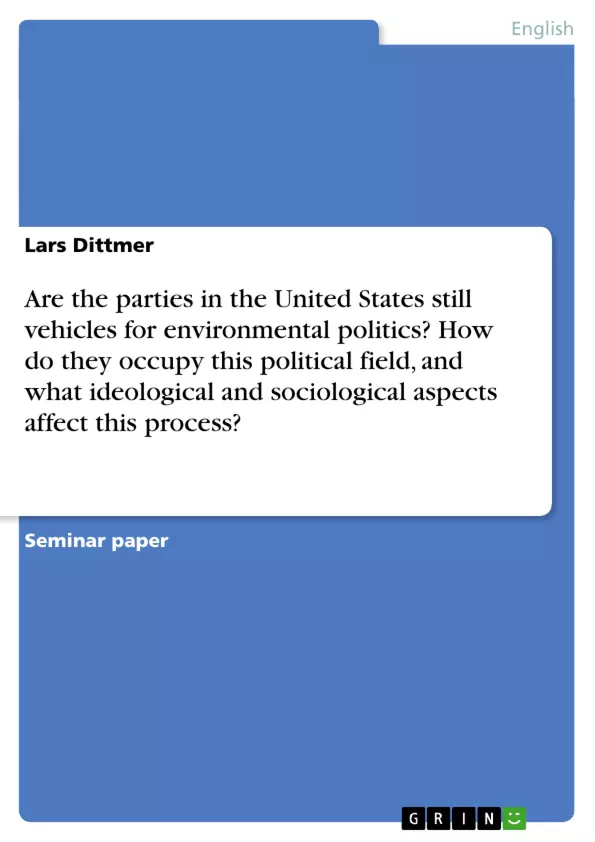„There is nothing so American as our national parks. The scenery and wildlife are native. The fundamental idea behind the parks is native. The parks stand as an outward symbol of this great human principle”. These sentences are not extracted from the platform of the American Green Party – they are from a quote of Franklin Delano Roosevelt, the 32nd President of the United States, a Republican. In his thinking, “conservation was closely tied to American Values” (Sussman/ Daynes/ West 2001: 169). During his governing period, environmental care was directly incorporated in governmental action – various agencies and bureaucracies were established to deal with this topic.
Today, the United States reject major international environmental treaties such as the Kyoto Protocol, requiring participants to reduce green house gases below the 1990 level by 2012. The Bush administration has presented plans to drill for oil in the Arctic National Wildlife Refuge, a swathe of land in northeast Alaska, populated by migratory birds, wolves and caribou. The House of Representatives had already approved these plans, the Senate rejected them. In voting George W. Bush their 43rd President, a majority of the American people made their cross for a candidate with a green record tending to zero.
But not only does environmental policy seem to have left the political agenda on a larger scale, observers more and more get the impression that the American people seem to care lesser for environmental aspects than ten or twenty years ago – only considering, among many other factors, the increasing number of polluting light trucks and SUVs on American roads. So can we conclude that, considering the fact that the parties fight for the support of the American mainstream, both Democrats and Republicans have banned environmental politics from their platforms?
This paper is to figure out to what extent the field of environmental policy still is a factor in the American political landscape and what ideological and sociological factors are at play in this process and in the party-internal treatment of the topic.
Inhaltsverzeichnis (Table of Contents)
- General Introduction
- Introduction and problem identification
- Approach of this term paper
- Environmental policy in the American discourse
- Ideological determinants
- Areas of Tension
- Economic efficiency vs. Ecology
- Sociogeographical variances
- Traditional labour versus modern production
- Translation into politics
- Parties and Positioning in the field
- Republicans: home for anti-environmentalists
- A "green" voting record in Congress: the Democrats
- The Green Party and environmental organizations
- Historical Perspective: Presidential performance
- "The Green Decade"
- The Eighties: Reagan and Bush
- Clinton and the 104th Congress
- Conclusion and outlook
Zielsetzung und Themenschwerpunkte (Objectives and Key Themes)
This term paper aims to investigate the role of environmental policy within the American political landscape, with a specific focus on the political parties. The paper examines the ideological and sociological factors that influence the parties' positions on environmental issues, exploring how these factors contribute to the internal party debate and the parties' actions in the political arena.
- The ideological and sociological determinants of environmental politics in the United States
- The tensions between economic efficiency and environmental protection
- The positioning of the major political parties (Democrats and Republicans) on environmental issues
- The historical perspective on presidential performance and environmental policy
- The role of environmental organizations and the Green Party in the American political landscape
Zusammenfassung der Kapitel (Chapter Summaries)
The introduction delves into the problem of environmental policy in the United States, highlighting the shift from a time when environmental care was central to national values, as exemplified by President Franklin Delano Roosevelt, to a period where the United States rejects major international environmental treaties and prioritizes economic interests over environmental concerns.
Chapter 2 explores the ideological determinants of environmental politics in the United States, highlighting the influence of conservative values and the perception of environmentalism as a leftist agenda. It then delves into the key areas of tension in US environmental politics, particularly the conflict between economic efficiency and ecological preservation. The chapter examines the societal and geographic factors that shape the debate, focusing on the tension between traditional labor and modern production methods.
Chapter 3 examines the positioning of the major political parties, the Republicans and Democrats, within the field of environmental politics. It discusses the Republicans' tendency to favor anti-environmental policies and analyzes the Democrats' record on environmental issues. It also explores the role of the Green Party and environmental organizations in the American political landscape.
Chapter 4 provides a historical perspective on presidential performance and environmental policy, examining the "Green Decade," the Reagan and Bush administrations, and the Clinton presidency.
Schlüsselwörter (Keywords)
The key themes and concepts of this paper include environmental politics, ideological determinants, economic efficiency, ecological protection, political parties, Republican, Democrat, Green Party, environmental organizations, historical perspective, presidential performance, and the American political landscape.
- Quote paper
- Lars Dittmer (Author), 2005, Are the parties in the United States still vehicles for environmental politics? How do they occupy this political field, and what ideological and sociological aspects affect this process?, Munich, GRIN Verlag, https://www.grin.com/document/49287



